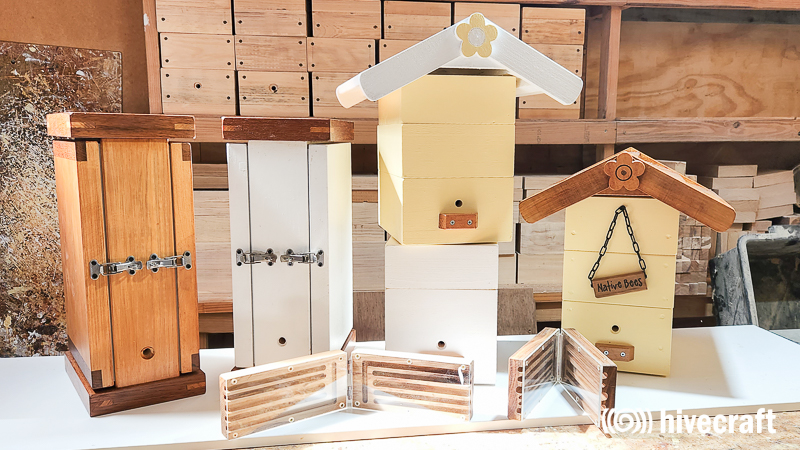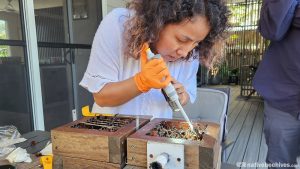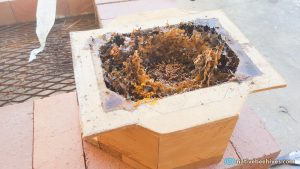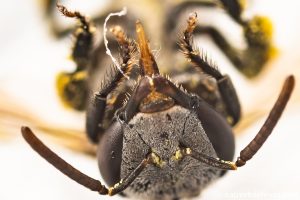Some people use a cover in winter to provide some insulation for their native bee hive. The most common cover is the styrofoam broccoli box.
There’s two methods used:
- Leave the cover on all the time 24/7
- Put it on at night and remove in the morning.
One issue with insulation is that if the colony is weak it will be colder. Adding insulation could make it in to an esky (cooler) and stop it from warming up during the day so it could actually be having a negative impact on the colony, but without some kind of testing we’re all guessing at a result.
- If the colony does well, how do you know the cover can be credited?
- Maybe the cover had no impact at all and we think it saved the colony.
- Maybe the cover had a negative impact and the colony was just lucky to survive it.
As with the other temperature tests done on this website, there will be a lot of variables and it could be impossible to get accurate results. Also, as with the other temperature test this project is likely to take years as we improve the testing methods. I hope to give an unbiased view, but I want to see a clear result.
Variables that can effect the results:
- Foam cover design and construction (mine is a bit patched together at the moment)
- Box construction materials
- Colony health
- Temperature probe position
- Box position
- Weather
- I’m sure there’s more
July 2024 – Winter
I actually started some tests last month in June but had some sensor and battery issues so am starting again with a different hive. Hopefully we’ll still get some kind of result from what is left of Winter. These tests will set us up a little better for next year by ironing out some bugs in the methods.
Hive used: The standard 25mm thick hoop pine OATH style box with stingless bees (Tetragonula carbonaria) which a lot of people have.
It’s not a particularly cold winter this year but we have to start somewhere. I’ve made a 30mm thick foam cover. Added the cover to the box 8am July 7 2024.



Update 10/07/2024: Chart below – Looks like we have a result, of course we have to consider all the variables. This is a fairly weak colony and will get higher temperatures in a strong colony. I’d rate my cover construction as average. A fully sealed cover may improve results and a thin broccoli box with no base or front may have less of an effect. There may be more significant differences in more extreme temperatures. The brood has a thick insulating involucrum during winter so is less effected by the outside temperatures.
My basic observations…
- The cover has slowed the reduction in heat over night for the honey pot area.
- The cover may have added another two degrees for the cold part of the day for the honey pot area.
- The cover isn’t allowing the honey pot area to warm up “as much” during the hottest part of the day.
- Removing the cover in the morning could help the honey pot area to warm up a couple of degrees during the day. (we’ll do that test).
- The brood temperature is a fraction warmer.
Chart below 13 July 2024: The full test in one chart.
The cover on the hive box for three days straight and then “on and off” for three days.
So if you’re chasing heat the best thing to do is to put a cover on each night and remove it each day. I’d recommend putting the cover on at 2pm as the temperature drops from there and taking it off around 8 or 9am.
But! All this is very unlikely to be necessary at all for 99.9% of hive owners so no need to rush out to find broccoli boxes. If you’re in more extreme areas with temperatures that get down to zero it might be more beneficial.
My main recommendation is to have your hive box in full sun during winter. The brood is what is important. If your colony is even half decently strong, they will have built a good insulating layer of involucrum around the brood. You don’t need to worry too much about the honey pot area.

Foam cover painted black
A follow up test for the foam cover. I painted the cover black to add more heat during the day. As with the previous test, adding the foam cover has reduced the heat loss over night and when painted black it adds more heat during the day compared to the previous test. *I wouldn’t leave this on in warmer months!
The hive box used here is top half 12mm thick marine ply where the probes are, and bottom half 25mm hoop. It will be split and matched up so it’s a complete 12mm marine ply box for more tests and comparisons with other boxes.

Summer Heat 2024
Foam cover painted white
Shown in the chart as the purple line, it looks like it kept the box cooler than any of the roofs. The white paint reflecting the sun and the foam insulating the box delayed the heat significantly.













